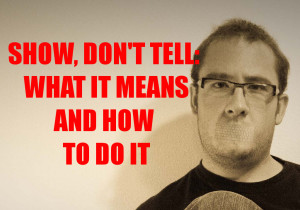It’s the first rule of writing. We hear it all the time. In fact, it’s almost all we hear. Over and over again, they tell us…
Show, don’t tell.
Show; don’t tell.
Show! Don’t tell!
In the name of all that’s good, what the heck does that mean???
Well, it’s kind of complicated. And it’s kind of hard to put your finger on it. And it’s kind of going to take more than one blog post. But let’s start with something simple.
Description!
Remember how we had so much fun guessing who the voices in Voice Week were, and where they came from and why they did the things they did?
We were able to do that because the writers were showing. Show Don’t Tell really means “don’t say it; convey it.” Separate facts from opinion, and then tell the facts in a way that guides your readers to the right opinion. In other words; don’t tell your readers the princess is beautiful; describe her in such a way that your readers say she’s beautiful.
Here’s an example:
She had long blonde hair and green eyes. She was beautiful.
Meh. Laundry list followed by the writer telling me what to think. Here’s a version that shows:
Her golden hair flowed all the way to her waist, and her eyes flashed, green as emeralds.
Cliché, I know, but the point remains: I never used the word beautiful; I didn’t have to. Words like golden, flowed, and emeralds show us she’s beautiful.
Now let’s step it up and try to cut out the cliché. Another way to show is to write the reactions of other people. Show the reader how the princess makes the knight feel. Not like this:
She made him feel nervous.
Or even this
He grew self-conscious under her gaze.
That’s telling your reader he’s nervous and self-conscious. Instead, give the reader clues and let them figure it out:
When she turned her head, her hair rippled, like wheat when the wind sweeps across it. When her green gaze fell on him, he forgot to breathe. When she smiled, his knees nearly gave out. And when she asked his name, his tongue stumbled all over his teeth to reply.
See how we used his physical reactions to show just how beautiful she is, without ever using the word? We also know the color of her hair without saying it.
We can even take the same laundry list (long blonde hair, green eyes) and twist it around completely:
Her hair, which stuck out in every direction, was lifeless and stiff, and exactly the same color as dead grass. He could imagine grabbing a handful and hearing a crunching sound. She felt his stare and glared back, but her eyes were lifeless as well, dull as a faded tapestry.
Ultimately, telling is just giving your readers knowledge. Showing is helping your reader see and hear and feel what’s happening. It’s the difference between being told the princess is beautiful, and believing the princess is beautiful.
—
Read more about Show, Don’t Tell:
Getting rid of background exposition (part 1)
Getting rid of background exposition (part 2)
Character sketches: telling to show
—

Show, don’t tell: What it means and how to do it




An old teacher once told me – “don’t tell your reader what your character is thinking. Rather, let it be obvious through his actions.” Still one of the best pieces of writing advice I have been given, even though it was years ago now!
Thanks for writing this post and helping me remember it 🙂
Excellent way to put it! Thanks for sharing.
So basic, and so often said, yet really, really difficult to apply! I’ll never tire of striving and learning to do this better.
Thanks for reminding us again, Stephanie! 😀
It seems everything in writing is easier said than done. : )
I love your vivid examples. I recently did a writing course where ‘show, don’t tell’ was emphasized. It’s painstaking work, but worth it in the end. 🙂 Thanks for sharing.
Thank you!
I remember one example my teacher gave me!
“My boyfriend writes my name in mustard every time he buys a hotdog for me.”
Oh, that is fantastic; I love it!
You make it look so easy, Stephanie.
Ha. That’s ’cause it’s just a few sentences. It gets to be paragraphs and pages, and the difficulty increases exponentially. But thank you. : )
This part comes in the next pahse of editing for me. Its a little tricky since I’m writing in first person, but I can see where the lessons still may apply.
The same rule applies for first person, and works the same way. A matter of “I couldn’t stop shaking” versus “I was scared out of my wits,” for instance. The difficulty lies in whether it is more important to state only what he sees (“the woman wrung her hands”) or what he infers (“she looked worried”)–the former actually helps us get inside his head better, because we have to infer with the character, instead of taking what he infers at face-value. If that makes any sense?
Wish it was easy as said…I have trouble with exactly what you have mentioned in this post. I tell, so much that my sister says it is just a sequence of event and not really flowing…shall try to change my style…
Ah, it’s a process. You’ll get there. : )
This often feels like an eternal struggle for me in my work. Oh if it were only simple!
yeah, why does the first rule have to be the hardest! But that’s what keeps us on our toes, I suppose.
Do we really need more things to keep us on our toes? Or fingertips? I think that writing, for those who really care about the craft and story-telling, is somewhat masochistic. Not that I don’t enjoy it, for I do. The constant re-writing and editing are rewarding, but equally frustrating.
You are so right. Nothing has been as much work as writing a novel. Basically, it is the impossible task. That will never be finished. And we keep hitting our heads against our computers and telling other people for God’s sake, don’t do what I did! Don’t become a writer! But ultimately, when we are writing, we are who we are supposed to be, and that’s the best feeling in the world. True artists don’t have to suffer for their art – they suffer because of their art.
Never finished… alas!
Heh. Aye. And I do love writing, and am not happy without it. My head would be so lonely without all of my characters! ^_~
Pingback: Show, Don’t Tell: how to get rid of background exposition « BeKindRewrite
Pingback: Show Don’t Tell: prove it « BeKindRewrite
Pingback: 5 query-writing tips you can learn from my horrible experience « BeKindRewrite
Pingback: Archives for the Holidays: Show, don’t tell: what it means « BeKindRewrite
Pingback: How to get rid of background exposition PART 2 « BeKindRewrite
Pingback: How to Stop Boring Your Readers with Scenic Description | bekindrewrite
Pingback: Show, Don’t Tell: how to get rid of background exposition | bekindrewrite
Pingback: Show Don’t Tell: prove it | bekindrewrite
Pingback: 6 Elements of Character Appearance that Go Way Beyond Eye Color - bekindrewrite
Best Show, Don’t Tell I’ve ever had explained to me. Thank you, now I’ve got to put it to work.
Thanks!
Thanks so much, Bryce! I’m glad it was helpful!
I abhor and boycott any fiction that follows your evil “show, don’t tell” injunction; consequently, there is no way I will be dissuaded by any of your propaganda from telling shamelessly and incessantly instead of showing.
How would you say ? The garden is beautiful.